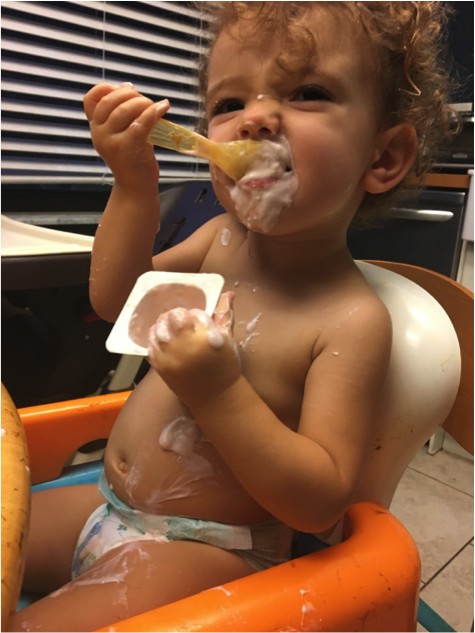My daughter Alice is seventeen months old and she is learning how to eat with a spoon. The cleanup at mealtime is out of this world! This stage of development is one of the hardest for me as a mom because I find myself just wanting to pick up the spoon and put the food in my daughter’s mouth for her. Not only do I want to do this for the sake of cleanliness but also for the sake of efficiency. Sometimes Alice will let me help her guide the spoon to her mouth. But most times, when I reach to help her with the spoon, she yells, “Mine!” and clutches the spoon to her chest. When the coast is clear and she knows I won’t intervene, she attempts to get more food on the spoon, the food goes everywhere, and the cycle continues.

Alice’s strong-willed desire to feed herself independently reminds me that my job as a mom is to support her in her quest for independence, even if things might get a little messy. In reality, that’s the end goal right? We want to raise confident and independent children who will become confident and independent adults. My job isn’t to keep everything efficient, tidy, and easy. My job isn’t to have everything occur on my timeline. I have to let Alice be Alice. Yelling “Mine!” reminds me that this is her experience. This new skill is for her to figure out. That forceful, “Mine!” is Alice telling me to give her space to figure this out. If she needs me to intervene, she’ll let me know.
Alice’s demands for independence remind me that our work as teachers is to provide time and space for students to interact with high quality curricula that let them do the work while we coach from the sidelines. Sometimes this can be simple, and other times quite complex. One of the strong supports for making decisions about when to let students struggle and when to intervene is an intervention reference sheet for the Being a Reader program we are using for Tier 1 instruction for foundational skills in kindergarten through second grade.
In Being a Reader, students work in a whole group with a teacher and small groups with and without a teacher. Teachers collect data through Mastery Tests and Individual Reading Observations to ensure that students are progressing and that their individual needs are being met. Each day, every student has solid opportunities within a high-quality, research-based curriculum to learn how to read. In many cases, this curriculum will do exactly what it’s meant to do and before we know it, those foundational skills begin to gel and the students are reading. Some students may learn to read quickly and others may take a bit longer. Some students may need re-teaching or more focused small-group instruction. Are these modifications intervention, or simply differentiation? When is the “right” time for a student to formally receive intervention, and what should the intervention be?
The multi-tiered system of supports (MTSS) framework in place in our school helps us organize instruction, allocate resources, and integrate intervention services. Within this framework, there are three tiers. In Tier 1 we provide core universal instruction to all students; in Tier 2 we provide targeted supplemental supports; and in Tier 3 we provide the most intensive individualized supports. We use progress monitoring data to make collaborative decisions about when students need to receive additional supports. Access to support is fluid. Students who respond to intervention may be removed from tiered support.
Because there are many things to consider when making these decisions, Collaborative Classroom provides an MTSS resource for Being a Reader that provides guidance about when students may need additional supports based on their placement and progress in the program at different times of the year. The goal of the resource is to help teachers make decisions about when Tier 2 may be appropriate and what Tier 2 intervention with Collaborative Classroom’s SIPPS intervention program could entail.
It’s hard for us as teachers not to sweep in, raise the scaffolding, and provide intervention right away when a student’s learning isn’t on our timetable. But just as I need to allow Alice to struggle, we need to adjust our supports to students based on their individual progress. We don’t want to leave struggling students to figure things out to the point of frustration. But we also don’t want to rush in too early to provide an additional layer of instruction if it’s not needed. Collaborative Classroom’s MTSS resource document for Being a Reader guides teachers in making these decisions.
The next time you are faced with a student who does not seem to be identifying his or her letters correctly or who just can’t remember that sight word, picture the student looking at you, with their book clutched to their chest, saying, “Mine!” Ultimately, students want us to give them the tools they need to help themselves. Should you provide scaffolds and then step back and let them continue to work? Or is it time to add the layer of Tier 2? Remember, this is their literacy experience, not ours.
Read Ashley’s next blog here!
